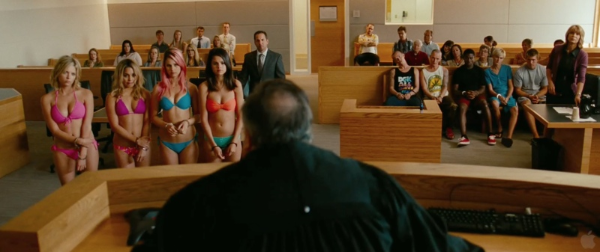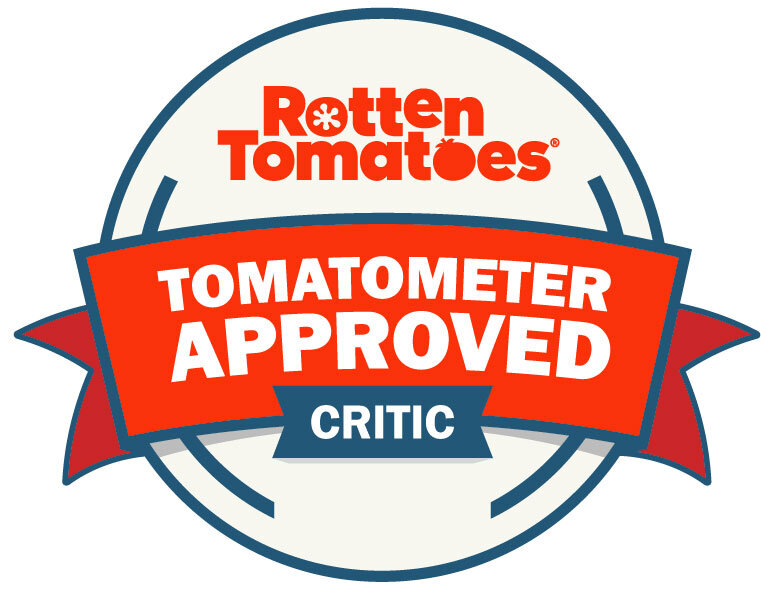2012 // USA // Harmony Korine // March 31, 2013 // Digital Theatrical Projection (Landmark Tivoli Theater)
Spring Breakers is a downright perplexing film. From a purely formal perspective, it is a quite handsome work, as cinematically impressive as anything writer-director Harmony Korine has created. In fact, it is far more striking to the eye and ear than its insipid, irksome story calls for, which makes it difficult to dismiss the film’s arresting aesthetic. In a sense, that aesthetic is all Spring Breakers has going for it.
There are plenty of elements to admire on the film’s glistening surface. There’s the gorgeous cinematography by Benoît Debie, who gives the nocturnal scenes a neon- and fluorescent-lit griminess that recalls his work on Gaspar Noé’s Irreversible and Enter the Void. There’s the spellbinding and chronologically jumbled editing by Douglas Crise, which cribs unapologetically from the works of Michael Mann and Terrence Malick to create a sense of dreamy reverie (or nightmarish dissolution) around particular sequences. There’s the mesmerizing sound design, with its buzzing, repetitive use of narcotic voiceover and its relentless punctuation of smash-cuts with gunshots and racking pistols slides. There’s the superb score by Cliff Martinez and Skrillex, which shifts smoothly between mournful waves of ambient sound and sweaty 140 BPM aggression.
However, beneath all of these enticing visual and aural components, the film presents a vacuous story about very stupid people doing very stupid things for reasons that never make much sense. Doubtlessly, Spring Breakers is the most lovely film ever made about vacationing bikini-clad undergrads who are enticed (with only a little prodding) into the criminal underworld.
The women in question are Faith (Selena Gomez), Candy (Vanessa Hudgens), Brit (Ashley Benson), and Cotty (Rachel Korine), who together attend a bleak, anonymous Middle American college campus. The four are short on cash and desperate to flee their dreary surroundings for the spray-tanned bacchanalia that is Spring Break in Florida. Candy, Brit, and Cotty formulate a plan to rob an all-night greasy spoon with water pistols in order to secure their escape to warmer climes—although the three conceal this scheme from the comparatively straight-laced, church-going Faith until after the fact (Faith... get it?). Wad of ill-gotten gains in hand, the coeds are then off to the Sunshine State to indulge themselves in all the Spring Break excess that can be had by straight, attractive, college-age women. (Which, it turns out, is quite a lot.)
Eventually, the days-long streak of hedonism comes to a screeching halt when the women are caught up in a police raid on a cocaine-fueled hotel party. The girls are broke, but their bail is unexpectedly paid by a leering hip hop artist and up-and-coming drug mogul named Alien (James Franco), who assures the ladies through his dollar-sign-studded silver grill that he has no ulterior motive (*oily chuckle*). Faith prudently gets the hell out of Florida at this point, but the remaining three girls shack up in Alien’s opulent beachfront abode, which boasts a poolside white grand piano, a television on which Scarface plays on an endless loop, and a truly ridiculous arsenal of firearms and martial arts weapons. In short order, Alien has talked his playthings into working as his pink-masked accomplices in a war on rival kingpin Archie (Gucci Mane). Or did the women talk him into it? Increasingly, it becomes apparent that the borderline-sociopathic Candy and Brit have no intention of ever returning to their former life of glum cinderblock dormitories and yawn-inducing history lectures.
If all of this seems fairly inane and even tedious... well, it is. The clash between Spring Breakers’ exploitative content and arty style is so glaring that the whole film just ends up feeling miscalculated and broken. Dissonance between form and content can make for a fascinating work in the right hands, but Korine is utterly uninterested in utilizing that dissonance in any meaningful way. Admittedly, the film does acknowledge the ludicrousness of the criminal antihero narrative by repackaging it in a gaggle of dim-bulb party girls. And, truth be told, there are flashes of coal-black humor here and there. One highlight: the girls’ voicemail messages to their family, which are overflowing with gushing descriptions of Spring Break’s distinctive, wholesome magic—in contrast with the out-of-control, licentious reality. It’s not exactly subtle, but the girls’ words are so ludicrously gooey and breathlessly disingenuous that the irony is pretty damn scrumptious.
Such moments are rare, however. The film’s fundamental problem is that it doesn’t really function on any level save the most lurid. Certainly, it doesn’t work as a satire of anything that is truly deserving of rhetorical savagery, and where worthy targets are concerned, it tends to pull its punches. The film is ambiguous with respect to Spring Break as a cultural phenomenon, for while Korine’s screenplay seems to recognize the staggering idiocy of the whole thing, it never takes an outright scolding stance. At times, the film even seems envious in its depiction of the celebrants’ beer-spattered, pot-clouded, hyper-sexual hijinks.
Perhaps most annoyingly and predictably, the film doesn’t offer any substantive engagement with sexism—or if it does, its criticisms are so obfuscated by the camera’s ogling of the female form that they might as well not exist at all. Spring Breakers is empowering in the crudest sort of way: by pressing handguns and assault shotguns into the hands of pretty white women. (Never mind the film’s excitement at the sight of those ladies cold-bloodedly exterminating countless Scary Black Men. Likewise the film’s almost oblivious use of lazy racial stereotypes.) It doesn’t seem to occur to Korine to expend his energies on little things like characterization, since that might distract from the bloodshed and sex appeal. Of the four female leads, only Faith is given any well-defined traits, in that she is the Christian and the sole woman who displays a reasonable wariness regarding Alien’s intentions. Cotty is generally portrayed as the most libertine of the four, and Candy and Brit as secretly ruthless and cruel, but that is about as much character detail as the film will allow in its female protagonists.
This dearth of characterization is not merely a matter of a problematic attitude towards gender, but of the film’s vexing mismatch between style and content. If a filmmaker is going to create a scuzzy, lurid crime thriller which is set in Carl Hiaasan country and looks and sounds like a hybrid of Badlands and Heat, it damn well needs the kind of forceful script and performances that can support such a chilly, oneiric approach. Neither Korine nor his actors rise to the occasion in this respect, and the result is a film that feels almost shamefully hollow. While Spring Breakers mimics a work of nuanced psychological portraiture or a sardonic statement about American values, it’s really just a crass wallow in female objectification and over-the-top violence. There’s nothing wrong with a crass wallow from time to time, but artful crassness requires a nimbleness and sophistication that Spring Breakers is wholly lacking.









